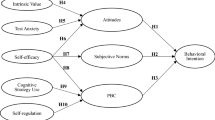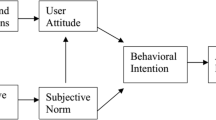Abstract
Conflicting perspectives exist regarding the application of the technology acceptance model (TAM) and the theory of planned behavior (TPB) to the study of technology acceptance behavior. The present study addressed the controversy by evaluating and comparing the predictive power of the two theories in a specific context, which was to measure students’ intentions to use a wiki for group work and their behaviors in doing so. A total of 174 students from a university in Hong Kong participated in the study. Three hypothesized models were examined using factor-based partial least squares structural equation modeling (PLS-SEM), which can account for measurement errors and is thus more robust than regression-based PLS-SEM. The results likely rebut the view that the TPB is inferior to the TAM. Moreover, this research highlighted the importance of social influences on collaborative e-learning.


Similar content being viewed by others
Explore related subjects
Discover the latest articles, news and stories from top researchers in related subjects.References
Ahmed, E., & Ward, R. (2016). A comparison of competing technology acceptance models to explore personal, academic and professional portfolio acceptance behavior. Journal of Computers in Education, 3(2), 169–191.
Ajzen, I. (1991). The theory of planned behavior. Organizational Behavior and Human Decision Processes, 50(2), 179–211.
Ajzen, I., & Fishbein, M. (2005). The influence of attitudes on behavior. In D. Albarracin, B. T. Johnson, & M. P. Zanna (Eds.), The handbook of attitudes (pp. 173–221). Mahwah, NJ: Erlbaum.
Ajzen, I., & Manstead, A. S. R. (2007). Changing health-related behaviors: An approach based on the theory of planned behavior. In K. van den Bos, M. Hewstone, J. de Wit, H. Schut, & M. Stroebe (Eds.), The scope of social psychology: Theory and applications (pp. 43–63). New York: Psychology Press.
Badri, M., Al-Rashedi, A., Yang, G., Mohaidat, J., & Al-Hammadi, A. (2016). Students’ intention to take online courses in high school: A structural equation model of causality and determinants. Education and Information Technologies, 21(2), 471–497.
Bentler, P. M., & Huang, W. (2014). On components, latent variables, PLS and simple methods: Reactions to Rigdon’s rethinking of PLS. Long Range Planning, 47(3), 138–145.
Biasutti, M. (2011). The student experience of a collaborative e-learning university module. Computers and Education, 57(3), 1865–1875.
Bourgonjon, J., Valcke, M., Soetaert, R., & Schellens, T. (2010). Students’ perceptions about the use of video games in the classroom. Computers and Education, 54(4), 1145–1156.
Bourguignon, D., Yzerbyt, V. Y., Teixeira, C. P., & Herman, G. (2015). When does it hurt? Intergroup permeability moderates the link between discrimination and self-esteem. European Journal of Social Psychology, 45(1), 3–9.
Chen, M.-F., & Tung, P.-J. (2010). The moderating effect of perceived lack of facilities on consumers’ recycling intentions. Environment and Behavior, 42(6), 824–844.
Cheng, E. W. L., & Chu, S. K. W. (2016). Students’ online collaborative intention for group projects: Evidence from an extended version of the theory of planned behavior. International Journal of Psychology, 51(4), 296–300.
Cheng, E. W. L., Chu, S. K. W., & Ma, C. S. M. (2016). Tertiary students’ intention to e-collaborate for group projects: Exploring the missing link from an extended theory of planned behavior model. British Journal of Educational Technology, 47(5), 958–969.
Cheon, J., Lee, S., Crooks, S., & Song, J. (2012). An investigation of mobile learning readiness in higher education based on the theory of planned behavior. Computers and Education, 59(3), 1054–1064.
Chu, S.-C. (2011). Viral advertising in social media: Participation in Facebook groups and responses among college-aged users. Journal of Interactive Advertising, 12(1), 30–43.
Chu, T.-H., & Chen, Y.-Y. (2016). With good we become good: Understanding e-learning adoption by theory of planned behavior and group influences. Computers and Education, 92–93, 37–52.
Chu, S. K. W., & Kennedy, D. M. (2011). Using online collaborative tools for groups to co-construct knowledge. Online Information Review, 35(4), 581–597.
Cress, U., & Kimmerle, J. (2008). A systemic and cognitive view on collaborative knowledge building with wikis. International Journal of Computer-Supported Collaborative Learning, 3, 105–122.
Davis, F. D. (1989). Perceived usefulness, perceived ease of use and user acceptance of information technology. MIS Quarterly, 13(3), 319–340.
Dijkstra, T. K., & Henseler, J. (2015). Consistent partial least squares path modeling. MIS Quarterly, 39(2), 297–316.
Fishbein, M., & Ajzen, I. (2010). Predicting and changing behavior: The reasoned action approach. New York: Psychology Press.
Guo, Y., & Barnes, S. (2009). Virtual item purchase behavior in virtual worlds: An exploratory investigation. Electronic Commerce Research, 9(1), 77–96.
Hair, J. F., Hult, G. T. M., Ringle, C. M., & Sarstedt, M. (2014). A primer on partial least squares structural equation modeling (PLS-SEM). Thousand Oaks, CA: Sage Publication, Inc.
Hair, J. F., Ringle, C. M., & Sarstedt, M. (2011). PLS-SEM: Indeed a silver bullet. Journal of Marketing Theory and Practice, 19(2), 139–152.
Hsu, C.-L., & Lu, H.-P. (2004). Why do people play on-line games? An extended TAM with social influences and flow experience. Information and Management, 41(7), 853–868.
Kock, N. (2011). Using WarpPLS in e-collaboration studies: Descriptive statistics, settings, and key analysis results. International Journal of e-Collaboration, 7(2), 1–18.
Kock, N. (2014). A note on how to conduct a factor-based PLS-SEM analysis. Laredo, TX: ScriptWarp Systems.
Kock, N. (2015a). Common method bias in PLS-SEM: A full collinearity assessment approach. Laredo, TX: ScriptWarp Systems.
Kock, N. (2015b). WarpPLS 5.0 user manual. Laredo, TX: ScriptWarp Systems.
Kock, N. (2015c). Wheat four versus rice consumption and vascular diseases: Evidence from the China Study II data. Cliodynamics, 6(2), 130–146.
Kock, N., & Lynn, G. S. (2012). Lateral collinearity and misleading results in variance-based SEM: An illustration and recommendations. Journal of the Association for Information Systems, 13(7), 546–580.
Lee, J., Cerreto, F. A., & Lee, J. (2010). Theory of planned behavior and teachers’ decisions regarding use of educational technology. Educational Technology and Society, 13(1), 152–164.
Liu, I. F., Chen, M. C., Sun, Y. S., Wible, D., & Kuo, C. H. (2010). Extending the TAM model to explore the factors that affect intention to use an online learning community. Computers and Education, 54(2), 600–610.
Ma, W. W.-K., & Yuen, A. H. K. (2005). Comparing four competing models in e-learning system acceptance. In K. P. Mehdi (Ed.), Managing modern organizations through information technology (pp. 568–571). Hershey, PA: Information Resources Management Association.
Mak, B., & Coniam, D. (2008). Using wikis to enhance and develop writing skills among secondary school students in Hong Kong. System, 36(3), 437–455.
Marler, J. H., Fisher, S. L., & Ke, W. (2009). Employee self-service technology acceptance: A comparison of pre-implementation and post-implementation relationships. Personnel Psychology, 62(2), 327–358.
Mathieson, K. (1991). Predicting user intentions: Comparing the technology acceptance model with the theory of planned behavior. Information Systems Research, 2(3), 173–191.
Naismith, L., Lee, B.-H., & Pilkington, R. M. (2011). Collaborative learning with a wiki: Differences in perceived usefulness in two contexts of use. Journal of Computer Assisted Learning, 27(3), 228–242.
Ndubisi, N. (2006). Factors of online learning adoption: A comparative juxtaposition of the theory of planned behavior and the technology acceptance model. International Journal on e-Learning, 5(4), 571–591.
Onwezen, M. C., Bartels, J., & Antonides, G. (2014). The self-regulatory function of anticipated pride and guilt in a sustainable and healthy consumption context. European Journal of Social Psychology, 44(1), 53–68.
Rosenberg, M. (1965). Society and adolescent self-image. Princeton, NJ: Princeton University Press.
Rosenberg, M., & Kaplan, H. B. (Eds.). (1982). Social psychology and the self-concept. Arlington Heights, IL: Harlan Davidson.
Sánchez, R. A., Hueros, A. D., & Ordaz, M. G. (2013). E-learning and the University of Huelva: A study of WebCT and the technological acceptance model. Campus-Wide Information Systems, 30(2), 135–160.
Sarstedt, M., Ringle, C. M., Henseler, J., & Hair, J. F. (2014). On the emancipation of PLS-SEM: A commentary on Rigdon (2012). Long Range Planning, 47(3), 154–160.
Schepers, J., & Wetzels, M. (2007). A meta-analysis of the technology acceptance model: Investigating subjective norm and moderation effects. Information and Management, 44(1), 90–103.
Slagter van Tryon, P., & Bishop, M. J. (2009). Theoretical foundations for enhancing social connectedness in online learning environments. Distance Education, 30(3), 291–315.
Tan, P. J. B. (2013). Applying the UTAUT to understand factors affecting the use of English e-learning websites in Taiwan. SAGE Open. https://doi.org/10.1177/2158244013503837.
Taylor, S., & Todd, P. (1995). Understanding information technology usage: A test of competing models. Information Systems Research, 6, 144–176.
Teo, T. (2012). Examining the intention to use technology among pre-service teachers: An integration of the Technology Acceptance Model and Theory of Planned Behavior. Interactive Learning Environments, 20(1), 3–18.
Teo, T., Lee, C. B., & Chai, C. S. (2008). Understanding pre-service teachers’ computer attitudes: Applying and extending the technology acceptance model (TAM). Journal of Computer Assisted Learning, 24, 128–143.
Teo, T., & Noyes, J. (2011). An assessment of the influence of perceived enjoyment and attitude on the intention to use technology among pre-service teachers: A structural equation modeling approach. Computers and Education, 57(2), 1645–1653.
Testa, M., & Major, B. (1990). The impact of social comparisons after failure: The moderating effects of perceived control. Basic and Applied Social Psychology, 11(2), 205–218.
Venkatesh, V. (2000). Determinants of perceived ease of use: Integrating control, intrinsic motivation, and emotion into the technology acceptance model. Information Systems Research, 11(4), 342–365.
Venkatesh, V., & Davis, F. D. (2000). A theoretical extension of the technology acceptance model: Four longitudinal field studies. Management Science, 46(2), 186–204.
Venkatesh, V., Morris, M. G., Davis, G. B., & Davis, F. D. (2003). User acceptance of information technology: Toward a unified view. MIS Quarterly, 27(3), 425–478.
White, K. S., Brown, T. A., Somers, T., & Barlow, D. H. (2006). Avoidance behavior in panic disorder: The moderating influence of perceived control. Behavior Research and Therapy, 44(1), 147–157.
White, K. M., Smith, J. R., Terry, D. J., Greenslade, J. H., & McKimmie, B. M. (2009). Social influence in the theory of planned behaviour: The role of descriptive, injunctive, and in-group norms. British Journal of Social Psychology, 48, 135–158.
Wojciechowski, R., & Cellary, W. (2013). Evaluation of learners’ attitude toward learning in ARIES augmented reality environments. Computers and Education, 68, 570–585.
Woo, M., Chu, S., Ho, A., & Li, X. (2011). Using a Wiki to scaffold primary-school students’ collaborative writing. Educational Technology and Society, 14, 43–54.
Yayla, A., & Hu, Q. (2007). User acceptance of e-commerce technology: A meta-analytic comparison of competing models. In Proceedings of the 15th European conference on information system (ECIS) (pp. 179–190), September 10–14, Switzerland.
Acknowledgements
This study was funded by The Education University of Hong Kong (Grant Number: T0148). The author would like to thank the five anonymous reviewers for their insightful comments on earlier drafts of the paper.
Author information
Authors and Affiliations
Corresponding author
Ethics declarations
Conflict of interest
The author declares that he has no conflict of interest.
Rights and permissions
About this article
Cite this article
Cheng, E.W.L. Choosing between the theory of planned behavior (TPB) and the technology acceptance model (TAM). Education Tech Research Dev 67, 21–37 (2019). https://doi.org/10.1007/s11423-018-9598-6
Published:
Issue Date:
DOI: https://doi.org/10.1007/s11423-018-9598-6




